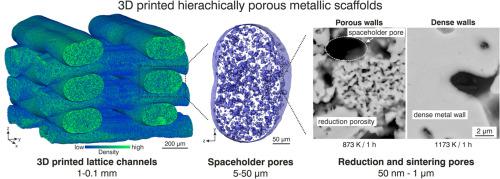Additive Manufacturing ( IF 11.0 ) Pub Date : 2020-10-01 , DOI: 10.1016/j.addma.2020.101637 C. Kenel , N.R. Geisendorfer , R.N. Shah , D.C. Dunand

|
3D ink-extrusion of powders followed by sintering is an emerging additive manufacturing method capable of creating metallic microlattices. Here, we study the creation of hierarchically porous Fe or Ni scaffolds by 3D extrusion of 0/90° lattices from inks consisting of fine oxide powders (Fe2O3 or NiO, <3 µm), coarse space-holder particles (CuSO4, <45 µm) and a polymer binder within a solvent. After space-holder leaching and debinding, a sintering step densifies the metallic Fe or Ni powders created by oxide reduction with H2, while maintaining the larger pores templated by the space-holder particles. The resulting Fe or Ni lattices exhibit a hierarchical porosity: (i) open submillimeter channels within the lattice between the printed struts; (ii) open micropores (5-50 µm) within the struts, from leaching of space-holder particles; (iii) closed submicron pores within the pore walls, from partial sintering of the metal microparticles created by oxide reduction. While the channel porosity is defined by the printed geometry, strut porosity is controlled by the sintering temperature, with the finest porosity removed first. Sintering at 873 to 1373 K for 1 h leads to strut porosities of 38 to 19% in Fe and 59 to 29% in Ni. In situ synchrotron X-ray tomography reveals the sintering kinetics and porosity evolution upon debinding, oxide reduction by H2 and sintering of the porous metal, which, combined, lead to ~50% shrinkage of the scaffolds as compared to the printed state. The space-holder templated pores are not eliminated by sintering and remain in the structure, but shrink upon reduction and sintering together with the surrounding metal matrix (e.g., by 40% in Fe and by 30% in Ni upon sintering at 1173 K for 1h).
中文翻译:

通过3D挤压和带有盐空间支架的氧化物微粒墨水的还原,形成多孔的金属支架
粉末的3D墨水挤压然后烧结是一种新兴的增材制造方法,能够形成金属微晶格。在这里,我们研究了3D挤压多孔或Fe或Ni支架的方法,该支架是从由细氧化物粉末(Fe 2 O 3或NiO,<3 µm),粗大空间保持颗粒(CuSO 4 , <45 µm)和溶剂中的聚合物粘合剂。在空间保持器浸出和脱脂之后,烧结步骤使通过H 2氧化物还原而生成的金属Fe或Ni粉末致密化。,同时保留由空间保持器粒子模板化的较大孔。生成的Fe或Ni晶格表现出分层的孔隙率:(i)在印刷支杆之间的晶格内开放的亚毫米通道;(ii)支柱内的微孔(5-50 µm)开放,这是由于空间保持颗粒的浸出引起的;(iii)由于氧化还原产生的金属微粒的部分烧结,孔壁内的封闭的亚微米孔。虽然通道的孔隙度是由印刷的几何形状定义的,但支杆的孔隙度是由烧结温度控制的,最细的孔隙度首先被去除。在873至1373 K的温度下烧结1 h,Fe的支撑孔隙率为38%到19%,Ni的支撑孔隙率为59%到29%。原位同步加速器X射线断层扫描显示脱脂,H氧化物还原后的烧结动力学和孔隙演化如图2所示,与多孔金属的烧结相结合,与印刷状态相比,多孔金属的结合导致支架的〜50%的收缩。保留空间的模板化孔不会通过烧结消除,而是保留在结构中,而是在还原和与周围金属基质一起烧结时收缩(例如,在1173 K烧结1h时,Fe减少40%,Ni减少30%) )。


























 京公网安备 11010802027423号
京公网安备 11010802027423号